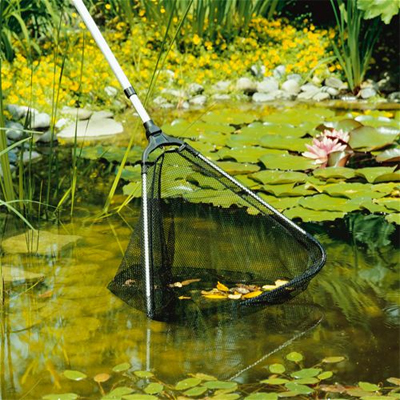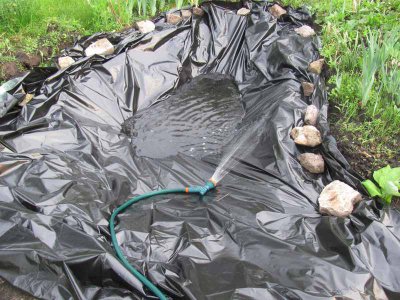A decorative pond on the household plot, no doubt, is very beautiful and original. Such an artificial reservoir will definitely decorate any landscape and will attract increased attention from others. However, so that he can please you with its uniqueness all year round for a decorative pond need to properly care.
Content
After all, decorative water, unlike natural, does not have the property of self-cleaning.
The process of care of the pond is not so time-consuming, as it may seem at first glance. Although it has its own characteristics and seasonal. What are its basic rules?
Basic rules of care for an artificial pond
- Periodic cleaning of fallen leaves, garbage, dead plants and other things to prevent the processes of rotting in water and the formation of Tina. Such work is made using a conventional stitch with a long handle.
 Fighting water flowing, which is a consequence of active reproduction of single-cell algae. For this, experts recommend, first of all, a pond to prevent a little, placing it in an appropriate place or plant plants having flat floating leaves, for example, nifia or cubes. This will limit light access to algae. In addition, another effective agent is plants-hydroxy agents, which excrete oxygen into water and absorb carbon dioxide, mineral salts.
Fighting water flowing, which is a consequence of active reproduction of single-cell algae. For this, experts recommend, first of all, a pond to prevent a little, placing it in an appropriate place or plant plants having flat floating leaves, for example, nifia or cubes. This will limit light access to algae. In addition, another effective agent is plants-hydroxy agents, which excrete oxygen into water and absorb carbon dioxide, mineral salts. In a small pond, transparent water is almost unrealistic, so for such a reservoir it is worth using various water filtration systems, for example, to establish a water purification filter or use chemical preparations to combat algae reproduction.
In a small pond, transparent water is almost unrealistic, so for such a reservoir it is worth using various water filtration systems, for example, to establish a water purification filter or use chemical preparations to combat algae reproduction.- For water bodies in which fish dwell, special devices must be used, which is saturated with oxygen water, so-called aerators.
 They resemble similar devices used in conventional aquariums, but more powerful and large in size. For feeding fish, it is important to use only food intended for these purposes and in the amount that they can eat at a time.
They resemble similar devices used in conventional aquariums, but more powerful and large in size. For feeding fish, it is important to use only food intended for these purposes and in the amount that they can eat at a time.
Seasonal care work for artificial pond
Spring
During this period of the year, starting from March of the month, it is necessary:
- check the condition of the pond for the integrity of the bottom, shores, etc.;
- the number of fish survivors after winter;
- equipment performance (filtration systems, pumps, etc.);
- to clean the reservoir from ice residues, watering it with hot water, as well as the garbage accumulated over the winter. To do this, it is advisable to completely roll out water from the pond, rinse the stones, walls and bottom to clean the brush and pour fresh water;
- prepare for plants disembarking, including pre-ready ready-made seedlings or seeds in the store, sear, if necessary, survived after winter, or feed fertilizers already available and not needing transplant.
Summer
- the avoidance of water evaporation is the main task in the summer. Due to the strong heat, it is necessary to closely monitor the water level in the reservoir and, if necessary, pour it with a thin weaving to a certain mark. To do this, it is important to use only the well-standing water and heated to the air temperature, so as not to harm the inhabitants of the reservoir.
- fight pests. Summer heat and high humidity can promote the reproduction of harmful microorganisms and pests that settle on the leaves and trunks of the plants. You can fight with such phenomena with the help of an ordinary water hose, wash off pests directly in the reservoir and making them a good food for fish.
- control over the purity of water. To do this, it is important to clean up the remnants of fish feed, accumulated on the surface of the garbage, do not disturb the biological balance in the reservoir, if necessary, the use of poisons and chemicals to clearly ensure that they do not get into water, etc.
- removal of weeds, including risas. It can be removed using special devices - skimmers that remove the top ball of water, as well as filters, etc.
Autumn
- cleaning leaves and pruning plants to prevent them from entering water. To do this, you can also install minor barrier grids, which will catch all the garbage. Periodically, they can be cleaned until the leavefall is completed.
- collection of winter kidney and thermal-loving plants to keep them until the next spring indoors. As well as the transfer of winter plants to the greatest depth of the reservoir to protect against cold.
- feeding fish with protein nutrition and their relocation to the aquarium or control over the water temperature in the reservoir, if the living inhabitants stay to winter.
Pond care in winter
- drain of water on the eve of cold weather, especially for small ponds with a depth of 50-100 centimeters;
- covering the pond film, boards or dense cloth;
- for fish, the remaining wintering needs to provide oxygen access. To do this, it is possible to regularly water the ice with hot water or install the electric water pump, which is equipped with a vertical drainage tube.
- supports optimal for the inhabitants of the water temperature of the water using the installation of a heat exchange tank equipped with an electronasus with a biofilter. Such a system should also have an automatic temperature sensor, which will control the degree of heating and save electricity.
In more detail how to build and care for a decorative pond on your summer cottage can be found by viewing the following video:























